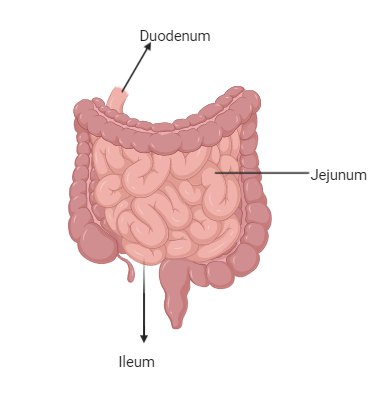Answer
405.6k+ views
Hint: The mechanism by which one glucose molecule is converted into two pyruvate molecules, two hydrogen ions and two water molecules are called glycolysis. The 'high-energy' intermediate molecules are synthesised via this process. The small intestine is a major part of the absorption of food in the gastrointestinal tract.
Complete answer:
(a) In the first stage of glucose oxidation, glucose, which is a 6-carbon molecule, is broken down into two pyruvate molecules (glycolysis). Glycolysis occurs in the cytoplasm of the cells. At the end of glycolysis, the pyruvate produced is then transferred to mitochondria where the pyruvate is completely oxidized to carbon dioxide.
(b)There is a small intestine present between the large intestine and the stomach. It is one of the most important parts of the food canal for both food digestion and absorption. There are three regions of the small intestine:

a) Duodenum, which is U-shaped.
b) Jejunum is the middle part and is coiled.
c) Ileum is the last region and is strongly coiled.
Absorbent cells or enterocytes are used to help absorb dietary nutrients and minerals in the small intestine. Tiny finger-like projections that normally present the lumen of the small intestine are villi. The length of each villa is 0.5 to 1.6 mm approximately. These finger-like projections help increase the surface area for food absorption. Villi, along with a large lymph vessel known as the lactate, consists of a network of capillaries. It helps in transporting lipid molecules. The intestinal wall is also surrounded by blood vessels that help transport food molecules to various parts of the body.
Note: The function of the small intestine is as follows; it helps to digest food, it also helps to extract minerals and nutrients from the digested food. The undigested food is transported from the small intestine to the big intestine.
Complete answer:
(a) In the first stage of glucose oxidation, glucose, which is a 6-carbon molecule, is broken down into two pyruvate molecules (glycolysis). Glycolysis occurs in the cytoplasm of the cells. At the end of glycolysis, the pyruvate produced is then transferred to mitochondria where the pyruvate is completely oxidized to carbon dioxide.
(b)There is a small intestine present between the large intestine and the stomach. It is one of the most important parts of the food canal for both food digestion and absorption. There are three regions of the small intestine:

a) Duodenum, which is U-shaped.
b) Jejunum is the middle part and is coiled.
c) Ileum is the last region and is strongly coiled.
Absorbent cells or enterocytes are used to help absorb dietary nutrients and minerals in the small intestine. Tiny finger-like projections that normally present the lumen of the small intestine are villi. The length of each villa is 0.5 to 1.6 mm approximately. These finger-like projections help increase the surface area for food absorption. Villi, along with a large lymph vessel known as the lactate, consists of a network of capillaries. It helps in transporting lipid molecules. The intestinal wall is also surrounded by blood vessels that help transport food molecules to various parts of the body.
Note: The function of the small intestine is as follows; it helps to digest food, it also helps to extract minerals and nutrients from the digested food. The undigested food is transported from the small intestine to the big intestine.
Recently Updated Pages
Mark and label the given geoinformation on the outline class 11 social science CBSE

When people say No pun intended what does that mea class 8 english CBSE

Name the states which share their boundary with Indias class 9 social science CBSE

Give an account of the Northern Plains of India class 9 social science CBSE

Change the following sentences into negative and interrogative class 10 english CBSE

Advantages and disadvantages of science

Trending doubts
Bimbisara was the founder of dynasty A Nanda B Haryanka class 6 social science CBSE

Which are the Top 10 Largest Countries of the World?

Difference between Prokaryotic cell and Eukaryotic class 11 biology CBSE

Differentiate between homogeneous and heterogeneous class 12 chemistry CBSE

10 examples of evaporation in daily life with explanations

Fill the blanks with the suitable prepositions 1 The class 9 english CBSE

Give 10 examples for herbs , shrubs , climbers , creepers

How do you graph the function fx 4x class 9 maths CBSE

Difference Between Plant Cell and Animal Cell



